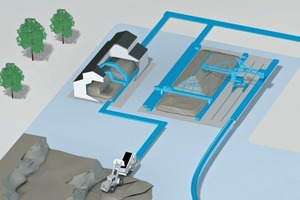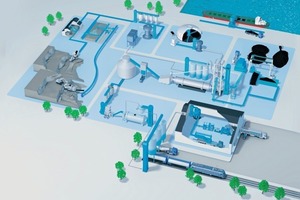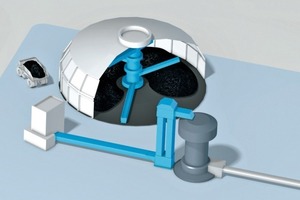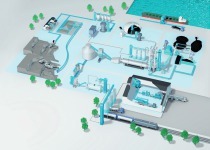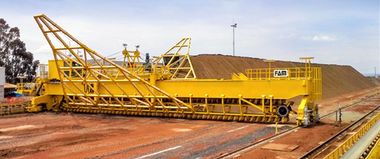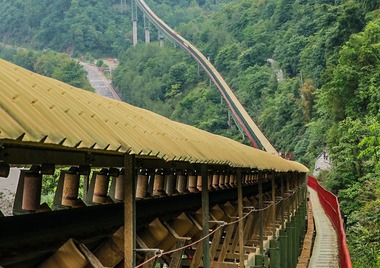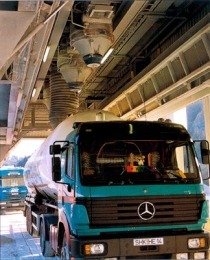Relying on regularity
In many industrial processes – as for example in the cement industry – the regularity of the raw materials used plays an important role in the manufacture of products. This uniform consistency is ensured through blending beds located within the storage yard. As a system supplier, BEUMER Group develops stackers and bridge scrapers, the essential components of blending beds, which stack bulk material reliably and guarantee a maximum blending effect. Thus, operators can homogenise large quantities of various bulk materials dependably and efficiently. BEUMER employees can perform the complete engineering of the blending bed systems (Fig. 1).
When the component raw materials for cement production are mined and transformed into cement at the cement plant, they pass through many different stages. The most important raw materials are limestone, clay and marl. Workers break them out of quarries or extract them with heavy tools. Wheel loaders and dump trucks transport the raw materials to the crushing facilities. There, the rocks are crushed to the approximate size of road gravel. These rocks then arrive at the cement works via miles long belt conveyors.
A consistent quality must be ensured so that the producers can further process the material to high-quality cement – fluctuations in the material characteristics must not occur. Therefore, a belt conveyor transports the individual raw materials to the blending beds. These storage location systems mix and homogenise the raw materials.
Experts at work
For almost 80 years, BEUMER has been developing tailor-made system solutions in conveying technology for the stone and quarry industry (Fig. 2), power plant industry, mining (ores and coal) as well as the logistics industry (harbours and transshipment terminals). Through structural analysis of the associated storage depots and calculation of dimensions, BEUMER is able to provide a design. The blending beds are customised according to their requirements. BEUMER proposes either longitudinal or circular stockpile designs. The recommended design shape results from the spatial conditions and the amount of the material to be stored. Depending on the field of application, BEUMER designed blending beds can be used at extreme ambient temperatures, for very high entry conveying capacities, as well as for the highest degree of homogenisation required. Additionally, BEUMER provides material-specific detailed solutions with robust and low-wear equipment. The environmental impacts are also very low as minimal noise and dust occurs during operation. Blending beds can be set up both outdoors and indoors.
Compiled and extracted in layers
The stacker and the bridge scraper are the basis for a blending bed. If they are perfectly designed, the user will obtain an optimum blending effect. BEUMER offers stackers that stack the bulk material efficiently and effectively. In the end, the stockpile has been raised so reliably that its cross-section shows as many layers of equal material as possible. The stackers can be of fixed or mobile types, depending on the requirement. In case of circular stockpiles the stackers are mounted onto a column and with a longitudinal blending bed, they are mounted on rails. The stackers are designed as fixed, raisable and pivotable booms with conveying capacities of up to 4000 t/h. The choice of the right system depends on different factors, as for example, the shape and size of the stockpile, the material, the throughput and the desired mobility (Fig. 3).
Lastly, the bridge scraper homogenises the material. It has a mobile rake on each side. The material is removed in layers by stroking the face of the stockpile with the rake. The scraper blades move the bulk material towards the belt conveyor which runs parallel to the stockpile. BEUMER bridge scrapers are not only robust, but they also transport the bulk material so that the product is handled gently. This makes them suitable for a variety of bulk materials. Their continuous and comparably simple working motions allow for a fully automated operation and ensure a constant and steady flow of the bulk material.
In the past, the new BEUMER team has completed remarkable projects in this field. One such example is an installation of a bridge scraper in Russia, which works at an ambient temperature as low as -40 °C. The rail width is 34 m and this bridge scraper is designed for a conveying capacity of 500 t/h. Furthermore, BEUMER has developed a stacker for coal mining, which is operated at ambient temperatures of -20 °C. This boom has a length of 41 m and the belt width measures 1.6 m. It transports 2250 t of bulk material per hour. BEUMER also engineered a bridge scraper with a rail width of 55 m that conveys 1100 tons of coal per hour.
//www.beumergroup.com" target="_blank" >www.beumergroup.com:www.beumergroup.com

